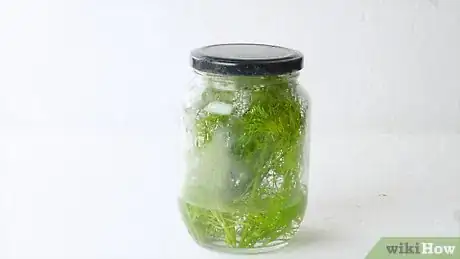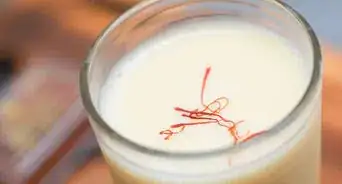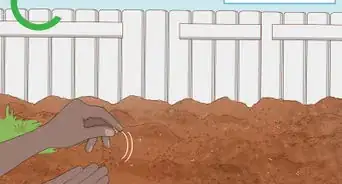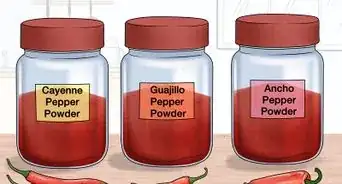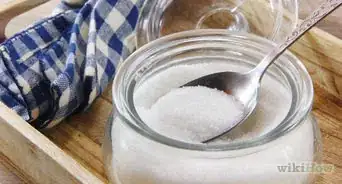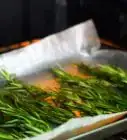This article was co-authored by Ollie George Cigliano. Ollie George Cigliano is a Private Chef, Food Educator, and Owner of Ollie George Cooks, based in Long Beach, California. With over 20 years of experience, she specializes in utilizing fresh, fun ingredients and mixing traditional and innovative cooking techniques. Ollie George holds a BA in Comparative Literature from The University of California, Berkeley, and a Nutrition and Healthy Living Certificate from eCornell University.
There are 11 references cited in this article, which can be found at the bottom of the page.
This article has been viewed 55,923 times.
When you think dill, you probably think crispy dill pickles (yum!). But the herb—which is a member of the celery family—is great for a lot of other recipes and uses, as well. Preserve fresh dill either in the refrigerator or the freezer, and add it to everything from chicken salad to marinades.
Things You Should Know
- Store fresh dill in the fridge. Rinse and dry the dill, then wrap it in damp paper towels. Place the bundle in a sealable plastic bag or container.
- Keep fresh dill in your crisper drawer for up to 1 week.
- You can also store fresh dill in the freezer for 6-12 months.
Steps
Storing Dill in a Crisper Drawer
-
1Rinse the dill under cool water and let it dry completely. Place the clean dill between 2 paper towels and pat firmly to remove extra water. Leaving even a little bit of water can make mold grow more easily.[1]
-
2Wrap the dill in a damp paper towel. Lay the herb lengthwise on the paper towel before rolling it up like a burrito. The moisture from the towel will prevent the dill from drying out without providing too much dampness which can lead to mold.[2]
- You want the towel to be moist, not soaking wet. Too much moisture will increase the chance of the dill going bad faster.
Advertisement -
3Set the paper towel full of dill inside an airtight container or resealable bag.[3] This will protect the dill from being exposed to oxygen while in the fridge.[4] Freezer bags are a great option here because they are specifically designed to have fewer chances of air leaks. Be sure to seal the container or bag tightly.
- If you're using a freezer bag, use your hands to press out any excess air in the bag before you seal it.
-
4Store the dill in the crisper drawer in your fridge for up to 1 week. The crisper drawer maintains a certain level of moisture meant to keep produce (including herbs) as fresh as possible.[5] Setting your crisper drawer control to high humidity will better prevent wilting, too.[6]
- Toss the dill out if you notice it’s darkening in color or if you see any signs of mold.[7]
Refrigerating Dill in a Jar
-
1Wash the dill in a salad spinner or in the sink until the water is clear. If you're using a salad spinner, place your dill inside of it and fill it with cold water. Swish the dill around in the water, then pour the water out. Spin the dill inside the spinner to dry the leaves. Pour out any excess water and repeat until the water is free of dirt.
- Never let dill soak while you’re washing it. This can remove some of the herb’s fragrant flavor.[8]
- If you don't have a salad spinner, you can simply rinse the dill under cool running water in the sink. However, this may not clean the dill as well as a salad spinner.
-
2Trim off stems and wilted leaves with kitchen scissors or a knife. By removing the stems, the dill can soak up water better, keeping it perkier and fresher for longer. And by cutting off any already wilted leaves, you reduce the risk of mold.[9]
-
3Stand the dill in a jar filled with 1 inch (2.5 cm) of water. Do this the same way you would with a bouquet of flowers in a vase. The trimmed ends of the herb should be in the water.[10]
-
4Cover the jar and place in the refrigerator. If the jar is big enough, cover it with the lid. If the dill sticks out the top, gently cover the jar with a plastic bag. This will not only keep moisture in the herbs, it will prevent the leaves of the dill from turning brown due to too much oxygen.[11]
- If you’re using a plastic bag, securing it around the jar with a rubber band helps stop oxygen from getting in and moisture from getting out.
- The best spot to keep your jar is in the door of the refrigerator. This is the warmest place so your dill won’t get too cold and dry out as fast.[12]
-
5Change the water every 2 to 3 days. Remove the dill from the jar, pour out the old water, and fill with fresh water. Place the dill back in the jar and cover tightly. You should change the water more frequently if you see that it becomes discolored.[13]
-
6Keep the dill in the refrigerator for up to 3 weeks. Get rid of the dill if you see moldy spots or if it becomes too limp or too brittle.[14]
Freezing Dill
-
1Clean the dill with cold water and let it dry on paper towels. A simple rinse in the sink should be enough to remove any dirt or insects. Lay the dill flat on a paper towel to dry completely.
- You want the dill to be dry enough that there is no moisture remaining (so it doesn’t freeze in a giant clump) but not dry to the point of being crunchy.[15]
-
2Remove any brown leaves with a knife or scissors but do not chop the dill. Over-chopping herbs can make them lose their flavor faster.[16] Keep the dill whole until you’re ready to use it.
-
3Seal the dill in a freezer bag or airtight container.[17] You can also freeze the dill in serving size portions (instead of all together) so you can conveniently just pull out what you need. If you're using a freezer bag, be sure to squeeze out any extra air before you seal it.
-
4Store the dill in the freezer for 6 to 12 months. After 6 months, the flavor may start to fade but it should stay good to eat (if stored properly) for 1 year.[18]
- When you're ready to use your dill, just remove it from the freezer and drop it into whatever you're cooking. It should defrost almost instantly if you're using heat like on a stove or in the oven. If you're using it in a dish that isn't being cooked, let it sit somewhere room temperature to thaw out first. It shouldn't take more than an hour.[19]
References
- ↑ https://tastessence.com/ways-to-dry-store-dill-weed
- ↑ https://www.thekitchn.com/your-guide-to-storing-fresh-herbs-in-the-fridge-231412
- ↑ Ollie George Cigliano. Private Chef & Food Educator. Expert Interview. 31 January 2022.
- ↑ https://www.thekitchn.com/your-guide-to-storing-fresh-herbs-in-the-fridge-231412
- ↑ https://www.today.com/food/how-keep-food-fresh-fridge-storing-it-right-place-t89496
- ↑ https://www.thekitchn.com/what-to-store-in-your-refrigerator-humidity-drawers-tips-from-the-kitchn-178094
- ↑ https://thepioneerwoman.com/food-and-friends/how-to-store-fresh-herbs/
- ↑ https://tastessence.com/ways-to-dry-store-dill-weed
- ↑ https://www.bonappetit.com/story/herb-prep-cleaning-tip
- ↑ https://www.thekitchn.com/your-guide-to-storing-fresh-herbs-in-the-fridge-231412
- ↑ https://www.thekitchn.com/your-guide-to-storing-fresh-herbs-in-the-fridge-231412
- ↑ https://www.today.com/food/how-keep-food-fresh-fridge-storing-it-right-place-t89496
- ↑ https://www.thekitchn.com/your-guide-to-storing-fresh-herbs-in-the-fridge-231412
- ↑ https://thepioneerwoman.com/food-and-friends/how-to-store-fresh-herbs/
- ↑ https://theinspiredhome.com/articles/3-ways-to-freeze-fresh-herbs
- ↑ https://www.today.com/food/herbs-101-how-cut-store-cook-fresh-herbs-t113705
- ↑ Ollie George Cigliano. Private Chef & Food Educator. Expert Interview. 31 January 2022.
- ↑ http://www.gettystewart.com/how-to-freeze-and-save-dill/
- ↑ https://www.seriouseats.com/2015/03/how-to-freeze-herbs-for-long-term-storage.html




